Adopting an Anxious Dog: 10 Tips to Soothe an Anxious Pup
From fear to confidence: Here’s how to help your newly adopted anxious dog feel more secure.
From fear to confidence: Here’s how to help your newly adopted anxious dog feel more secure.
by Katie Koschalk, | July 30, 2024

CoreyOHara / Adobe Stock
Adopting a dog with anxiety might seem daunting, and you might wonder if you can handle it. The good news is that while caring for an anxious dog may require a bit more time and effort (especially at first), these dogs can transform remarkably with the right care, blossoming into more confident companions.
“Seeing your anxious dog overcome challenges and learn new skills can instill a great sense of pride in both yourself and your dog, which can make any challenges worth it,” says Rachel Lane, MSc, CPDT-KA, CBCC-KA, a certified professional dog trainer and founder of Leash and Learn in New York City.
Let’s explore why adopting an anxious dog might be one of the most rewarding choices you’ll ever make, and how to help your Nervous Nellie feel more secure.
First things first, why do dogs get anxious? There are several possible reasons, and understanding them can help you better address and manage your pup’s behaviors.
Lack of socialization: Dogs who have had limited experiences in their lives are more likely to be fearful when encountering something new, such as visitors, new places, or various stimuli.
Changes in environment: Dogs are creatures of habit and can become anxious when their routines or environments change. Things like moving to a new home, the arrival of a new family member, or a change in their pet parent’s schedule can all trigger anxiety.
Lack of exercise and mental stimulation: Dogs who don’t receive adequate physical exercise or mental stimulation can become anxious and display destructive behaviors.
Past trauma: Many anxious dogs have experienced trauma in their past, such as abuse, neglect, multiple rehomings, abandonment, street life, or anything that deeply scared them. These experiences can leave lasting psychological scars, making them fearful or anxious in various situations.
Separation anxiety: Dogs who form very strong bonds with their pet parents can experience severe anxiety when left alone. This is particularly common among dogs who have faced abandonment before.
Health issues: Underlying medical conditions, such as pain, hormonal imbalances, and neurological conditions, can cause anxiety in dogs.
“The first thing to keep in mind is that there’s help for anxious dogs,” says Lane. “There are a lot of things that can be done to help lessen their anxiety and improve their quality of life.”
Helping an anxious dog requires a combination of understanding, patience, and specific strategies tailored to their needs. Here are some effective ways to support and soothe your nervous companion.
Before bringing your new dog home, set up a quiet room with all the necessities, including water, dog-safe toys, and a crate with a bed. This is your dog’s space to decompress and get accustomed to their new environment. Keep the door to the room closed or use a baby gate.
During this time, provide daily meals and quick bathroom breaks as usual. If your rescue dog is too fearful to go outside for bathroom breaks, place potty pads in the room to allow for stress-free elimination. Offer some affection and companionship (if they seem open to it), but not too much, as this can overwhelm them.
Allow your dog to get comfortable in this room before introducing them to the rest of the home. While this varies for each dog, anxious dogs typically need at least a week in their decompression room.
Maintain a calm and quiet environment in your home. Minimize loud noises, chaotic activities, and sudden changes that could trigger anxiety. In other words, skip the drum practice, blaring music, and surprise parties.
Establishing a consistent daily routine helps reduce anxiety by providing predictability. Regular feeding times, walks, play sessions, and bedtime routines can make your dog feel more secure.
Use positive reinforcement techniques to build your dog’s confidence and trust. Reward calm behavior with treats, praise, and affection. Avoid punishment, as it can increase anxiety and make your dog more fearful. Training sessions should be short, fun, and end on a positive note to keep your dog engaged and motivated.
Gradually expose your dog to anxiety-triggering stimuli in a controlled manner, pairing the exposure with positive experiences like treats and praise. For example, if your dog is afraid of the vacuum cleaner, start by placing the vacuum in the same room without turning it on. Slowly move the vacuum closer to your dog, and eventually, turn it on for short periods. Immediately reward your dog for staying calm. If your dog shows signs of fear, stop and revert to the previous step until they can remain relaxed.
“Anxious dogs thrive when given the ability to control and consent to interactions and experiences,” says Lane. “Allowing them to take things at their own pace, and giving them the option to opt-out when they don’t want to do something, helps build their confidence and improves their quality of life.”
Lane stresses the importance of not rushing your dog to conquer their fears, as this can intensify their anxiety and ultimately prolong the process.
Be your dog’s voice. For instance, if your dog seems scared of interacting with someone, politely inform that person they cannot pet your dog. Only expose your dog to situations they’re equipped to handle and where they show positive signs of acceptance, like approaching someone for attention.
Ensure your dog gets plenty of physical exercise and mental stimulation. Regular walks, playtime, puzzle toys, training games, and activities like agility can help burn excess energy and reduce anxiety.
Consider using calming products such as an anxiety vest for dogs, calming pheromone diffusers, or supplements designed to reduce stress and promote relaxation. These products can provide an additional layer of comfort and help manage anxiety symptoms.
Your dog will take cues from your behavior, so it’s important to remain calm and patient. Avoid reacting with frustration or anxiety, as this can exacerbate your dog’s stress. Instead, approach situations with a calm demeanor, offering reassurance and support to help your dog feel safe.
Some dogs with anxiety don’t show symptoms of their anxiety until after they’ve been brought home and are settled in, says Lane. “It can be upsetting when their anxiety begins to manifest later on.” But take heart — adopting a dog, even an anxious one, comes with many benefits.
Helps a dog in need: By adopting an anxious dog, you’re giving a home to a pet who might otherwise struggle to find one. This act of kindness can be deeply fulfilling, because you’ve made a significant positive impact on their life.
Deep bonding: An anxious dog who has learned to trust and feel safe can become an incredibly affectionate, devoted companion. Their appreciation for the security and love you provide can lead to an exceptionally strong bond.
Personal growth: Caring for an anxious dog can teach patience, empathy, and resilience. You’ll develop new skills and gain a deeper understanding of canine behavior, which can enhance your overall experience as a pet parent.
Sense of accomplishment: Witnessing an anxious dog transform into a confident pet is immensely satisfying. Each small victory, whether it’s a wagging tail or a relaxed demeanor, can bring a profound sense of accomplishment.
While caring for an anxious dog is usually manageable, it can also be emotional, especially when progress seems slow or setbacks occur. It’s important to maintain a positive (yet realistic) outlook and seek support when needed to manage the emotional demands. Consulting with a veterinarian and a dog trainer or behaviorist can provide you with the guidance and tools needed to address severe anxiety effectively.
To help a dog with separation anxiety, gradually acclimate them to being alone by starting with very short periods (a few minutes) and slowly increasing the time. Use positive reinforcement, rewarding them for remaining quiet and calm in your absence.
Anxiety can sometimes cause dogs to mark indoors. To address this, ensure your dog is neutered or spayed, and clean marked areas thoroughly to remove scents. Provide ample bathroom breaks outside, and use positive reinforcement to encourage appropriate behavior.
Sudden anxiety in dogs can be triggered by various factors, such as changes in routine, environment, or household dynamics. Loud noises, unfamiliar visitors, or health issues can also contribute.
Dogs get separation anxiety due to a strong attachment to their pet parents. Factors like changes in routine, moving to a new home, or previous abandonment can trigger or enhance this anxiety. These dogs fear being left alone, leading to stress.
Ready to add a dog to your life? Consider adopting a pup who just needs a loving, stable home to soothe their anxiety. Use Adopt a Pet’s search feature to find your new family member today and make a difference in their life.
Canine Separation Anxiety: Strategies for Treatment and Management

Katie Koschalk is a freelance writer based in Northern California. Fusing her love and knowledge of animals with her journalism degree and years of professional writing, Katie is dedicated to improving the lives of pets and their caretakers by sharing helpful and accurate information. When she’s not at her desk, you can find her exploring trails with her Aussie, Hunter, cooking plant-based meals, and talking to her two cats, Jax and Sadie, in really ridiculous voices.
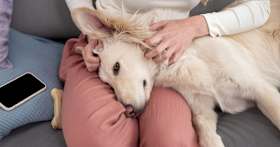
Behavior & Training
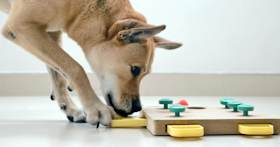
Behavior & Training

Behavior & Training

Behavior & Training
Does your dog experience separation anxiety? Explore helpful techniques to comfort and entertain your dogs while they
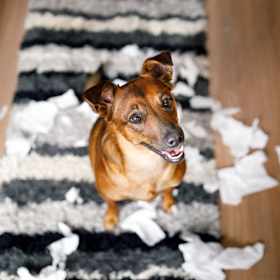
Behavior & Training
Is your dog bent on destroying everything in sight? (We know the feeling.) Here are the best ways to stop this destructive behavior.
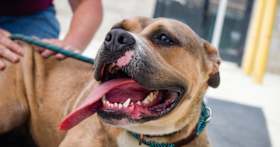
Shelters & Rescue
The antidepressant can be a godsend to anxiety-ridden dogs, as well as to pups prone to getting sick in shelters

Behavior & Training
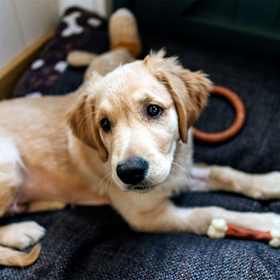

Behavior & Training
Licking can indicate anything from affection to anxiety to things just tasting good. Here’s what it may mean for your dog, plus tips on how to lessen the behavior.